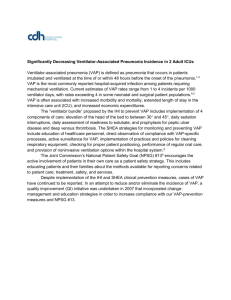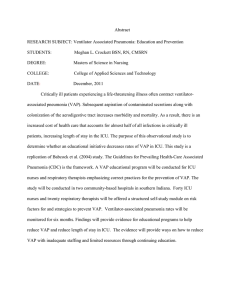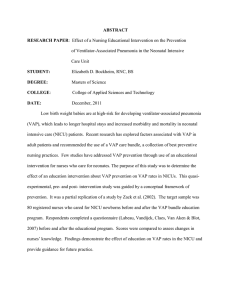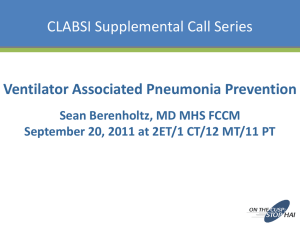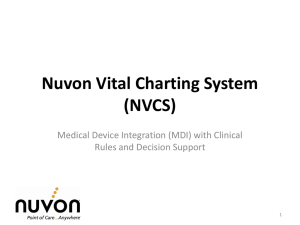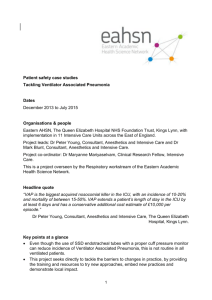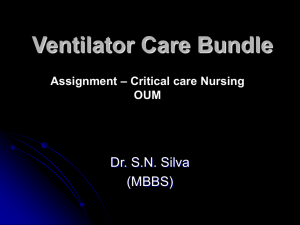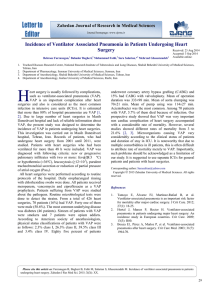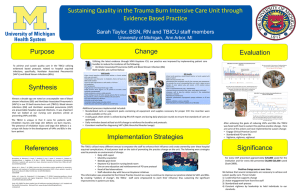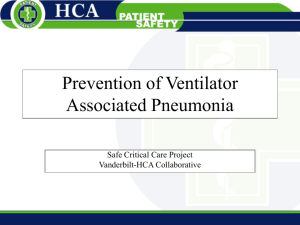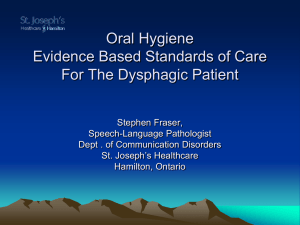Central DuPage VAP Elimination Pediatric 2010
advertisement
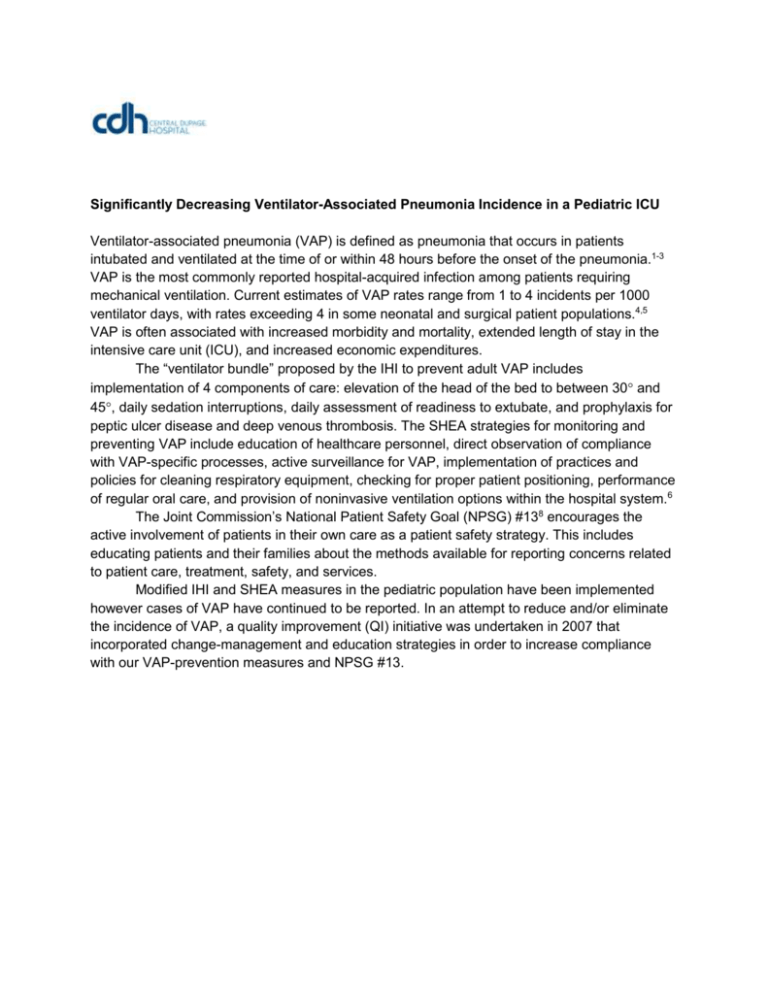
Significantly Decreasing Ventilator-Associated Pneumonia Incidence in a Pediatric ICU Ventilator-associated pneumonia (VAP) is defined as pneumonia that occurs in patients intubated and ventilated at the time of or within 48 hours before the onset of the pneumonia.1-3 VAP is the most commonly reported hospital-acquired infection among patients requiring mechanical ventilation. Current estimates of VAP rates range from 1 to 4 incidents per 1000 ventilator days, with rates exceeding 4 in some neonatal and surgical patient populations.4,5 VAP is often associated with increased morbidity and mortality, extended length of stay in the intensive care unit (ICU), and increased economic expenditures. The “ventilator bundle” proposed by the IHI to prevent adult VAP includes implementation of 4 components of care: elevation of the head of the bed to between 30 and 45, daily sedation interruptions, daily assessment of readiness to extubate, and prophylaxis for peptic ulcer disease and deep venous thrombosis. The SHEA strategies for monitoring and preventing VAP include education of healthcare personnel, direct observation of compliance with VAP-specific processes, active surveillance for VAP, implementation of practices and policies for cleaning respiratory equipment, checking for proper patient positioning, performance of regular oral care, and provision of noninvasive ventilation options within the hospital system.6 The Joint Commission’s National Patient Safety Goal (NPSG) #138 encourages the active involvement of patients in their own care as a patient safety strategy. This includes educating patients and their families about the methods available for reporting concerns related to patient care, treatment, safety, and services. Modified IHI and SHEA measures in the pediatric population have been implemented however cases of VAP have continued to be reported. In an attempt to reduce and/or eliminate the incidence of VAP, a quality improvement (QI) initiative was undertaken in 2007 that incorporated change-management and education strategies in order to increase compliance with our VAP-prevention measures and NPSG #13. The following modifications were made: 1. Increased tracking of compliance with the VAP-prevention bundle. 2. Intensive change-management strategies, including an evidence-based caregiver bundle and oral-care-protocol education using a multidisciplinary team approach. 3. Perform Oral Cleansing Every 2 Hours a. Replace covered oral suction device every 24 hours b. Use suction toothbrush twice a day c. Remove any oral appliances prior to brushing. Brush teeth and gums using suction toothbrush with q2h oral care kit consisting of a cetylpyridinium chloride (CPC) suction toothbrush and swabs treated with hydrogen peroxide plus CPC solution. Brush for approximately 1-2 minutes. Suction after brushing is complete to remove any particles in the mouth. Gently brush the surface of the tongue. For infants use small swabs with sterile water. d. Use suction swabs every 2 hours to clean teeth and tongue. e. Follow suction with moisturizer to lips and oral mucosa. f. Perform deep oropharyngeal suctioning as needed to assist in removing secretions. Use disposable suction catheter to perform this task. 4. Invite responsible family members to perform non-suction tasks when appropriate utilizing green swabs with mouth moisturizer, small infant swabs with sterile water, or assisting with maintaining head of bed at least 30 degree elevation. 5. Hang poster in room and discuss with family. 6. Wash hands, start assessment with ETT then proceed to oral care and remaining assessment. 7. Keep head of bed elevated to at least 30 degrees at all times. 8. Provide daily “sedation vacation” coupled with a minimum of daily assessment of the patient’s readiness for weaning. 9. Resuscitation bags should never be placed on the bed! Hang at bedside and replace when visibly soiled. 10. In-line suction catheters will remain continuously attached to suction tubing and will be changed when visibly soiled or mechanically malfunctioning. 11. Reduce inadvertent extubations. Diligently check ETT stabilization, document date and time on tape, change tape and positioning of tube a minimum of every 24-48 hours. Use umbilical clamp method for infants requiring 4.5 ETT or smaller. 12. Keep ETT cuff pressures between 20 and 30 cmH2O when cuff is utilized. 13. Staff empowerment and awards for protocol compliance. 14. Development of family education and involvement posters. 15. Ongoing qualitative metrics to understand the need for additional education and changemanagement strategies and to identify knowledge gaps that should be addressed. 16. Quantitative metrics that demonstrate compliance and VAP rates and the need to visually share this information with staff on an ongoing basis. RESULTS In a 7 bed Pediatric intensive care unit, 1200 days have occurred without a ventilator acquired pneumonia. REFERENCES 1. Richards MJ, Edwards JR, Culver DH, Gaynes RP. Nosocomial infections in medical intensive care units in the United States: National Nosocomial Infections Surveillance System. Crit Care Med 1999;27:887-892. 2. Safdar N, Dezfulian C, Collard HR, Saint S. Clinical and economic consequences of ventilator-associated pneumonia: a systematic review. Crit Care Med 2005;33:2184-2193. 3. Ibrahim EH, Tracy L, Hill C, Fraser VJ, Kollef MH. The occurrence of ventilator-associated pneumonia in a community hospital. Chest 2001;120:555-561. 4. American Thoracic Society, Infectious Diseases Society of America. Guidelines for the management of adults with hospital-acquired, ventilator-associated, and healthcareassociated pneumonia. Am J Respir Crit Care Med 2005;171:388-416. 5. Institute for Healthcare Improvement. Ventilator-associated pneumonia (VAP) rate per 1000 ventilator days [Internet]. http://www.ihi.org/IHI/Topics/CriticalCare/IntensiveCare/Measures/VentilatorAss ociatedPneumoniaRateper1000VentilatorDays.htm. Accessed December 19, 2009. 6. Coffin SE, Klompas M, Classen D, Arias KM, Podgorny K, Anderson DJ, et al. Strategies to prevent ventilator-associated pneumonia in acute care hospitals. Infect Control Hosp Epidemiol 2008;29(suppl 1):S31-S40. .
